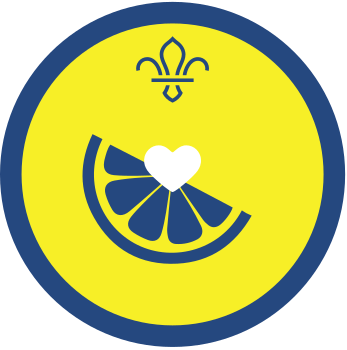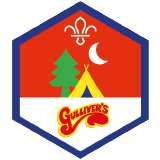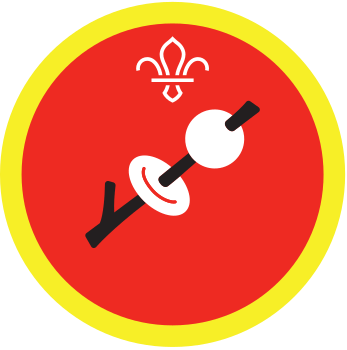
Barbecued banana boats
You’ll need
- Knives
- Spoons
- Bowls
- Chopping boards
- Coloured pens or pencils
- Pens or pencils
- Access to a campfire or barbecue
- Cooking tongs
- Fire bucket
- Tin foil
- Bananas
- A selection of fillings (see instructions for suggestions)
To watch in full screen, double click the video
Before you begin
- Use the safety checklist to help you plan and risk assess your activity. There's also more guidance to help you carry out your risk assessment, including examples. Don’t forget to make sure all young people and adults involved in the activity know how to take part safely.
- Make sure you’ll have enough adult helpers. You may need some parents and carers to help if you’re short on helpers.
- Build and light a fire before starting this activity. Our activities, Campfire admirers or Construct a campfire, can help you to do this.
- You’ll use the hot embers to cook on, so the fire will need enough time to die down before cooking. All the fires need to burn down to hot embers before they can start cooking. This decreases the chance of carbon monoxide being present and also gives the best cooking heat. We have more guidance on different cooking methods.
- You could run our fire safety activities, Fuel air ignition and Sitting safely by a campfire, prior to running this session.
- Make sure that everyone’s fires have been built outdoors in clear, open areas, with plenty of ventilation, and away from any areas where people will be sleeping.
- Remember to have a hand washing station and take extra hygiene precautions when handling food. Look at our guidance on food preparation.
- Make sure you have all the ingredients ready.
- Remember to brief young people on the safe use of their individual responsibility to behave safely around fires, including on the possible dangers of firelighting, never reaching over fires or flames, and how to approach fire safely. You may want to show how to safely use equipment before young people use them.
- There should be a bucket of water and a spade handy at all times, for emergencies.
- No-one should throw anything into the flames – tell the groups this when you arrive.
- Appropriate footwear and clothing to be worn around fires. People should avoid loose clothing, so tuck in Scout neckers and watch out for open coats, sleeves and scarves.
- Everyone should tie back loose hair and wear closed toe shoes.
- Remember to never reach over fires or flames.
- Make sure there is an appropriate first aid kit available, including for burns, and that adult volunteer learning is up-to-date. Remember to never reach over fires or flames.
- The wind direction needs to be considered and allowed for. Responsible adults should supervise young people, and remind them to remove themselves from the smoke if wind direction changes.
- Barbecues must be located on specified surface, such as camp fire circle. They could also be well off the ground on a stable platform, such as an altar fire on designated ground slab. Never have a barbecue located over damageable surfaces, such as tarmac or grass.
- Barbecues must never to be left unattended. After use, barbecues to be left in a safe manner, doused with water to prevent stray sparks.
- Remember to have a hand washing station and take extra hygiene precautions when handling food. Take a look at our guidance on food preparation.
- Make sure you have all the ingredients ready.
- Remember to check your ingredients against any allergy or dietary requirements to ensure everyone can enjoy the recipe. This may mean using alternative ingredients.
- Follow our food preparation guidelines to avoid the cross contamination of different, or raw and cooked, foods.
- Care should be taken to make sure equipment has fully cooled before moving it at the end of the session.
- Young people should be briefed and reminded on safety around hot food, including not to touch it and allow it to cool before eating.
- Use thick, heat-resistant gloves when putting items on and off a fire with tongs.
- Never reach over fires or flames.
Getting ready to cook
- On a clean, flat surface, set out your chosen ingredients in bowls. Remember to put spoons with each ingredient.
- Set out the bananas on boards with a knife.
- Gather everyone together in a circle and tell them you’re going to make Barbecued Banana Boats.
- You may want to run a fire safety talk or show people how to use the equipment safely, such as for cooking on a campfire or chopping ingredients.
Barbecue your bananas
- Everyone should stand by a banana. Making sure their banana is lying down so it can’t roll, each person should use their knife to carefully slice their banana lengthways, starting from just above the base and finishing just below the tip. Everyone should keep the skin on their banana.
- If anyone doesn’t like bananas, you could use apples or pears for this activity. You may need different knives to safely slice apples and pears. If using sharp knives, make sure you have enough people to supervise the group closely.
- Next, everyone should cut a few horizontal slits on the top side of their banana. Space these evenly and don’t slice all the way through. The cuts let the banana expand as it cooks.
- Give each person an A4-sized sheet of foil. The bananas should be placed in the centre of the foil, with the sliced side facing up.
- Everyone should now take turns to fill their banana with ingredients of their choosing from the bowls. Each person should use the spoons provided to add their fillings to the open cuts in the banana. Some flavour combinations that we enjoy include:
- Raspberries, orange and blueberry
- Strawberry, raspberry and yoghurt (add yoghurt after cooking)
- Almond, raisin and blueberry
- Honey, candied ginger and orange juice
- Blueberry, coconut and peanut butter
- Chocolate, pomegranate seed and pistachio
- Everyone can now wrap their banana in the foil tightly, making sure there are no gaps. To seal the banana, scrunch the ends of the foil.
- A responsible adult, wearing heat- or fire-resistant gloves, can now use cooking tongs to place the bananas onto a barbecue to cook. Make sure that this stage is closely supervised.
- Once everyone’s bananas are on, they should be left to cook for between 10 and 15 minutes. Remember, some ingredients will take longer to cook than others. You can tell when bananas are cooked as their skin will darken and insides will go mushy.
- When the bananas are ready, a responsible adult who's wearing heat- or fire-resistant gloves should use tongs to carefully remove the barbecues from the heat. Place the bananas on a heat-proof surface, such as a baking tray, and leave them to cool for a short while, out of the reach of young people.
- When cooled, people should carefully open the foil and eat the banana. You could serve it with ice cream or similar, again remembering to check dietary requirements or allergies.
We divide food into five main groups. We need a variety of food from each of the groups to get all of the nutrients our bodies need. We don’t need to achieve this balance with every meal – it’s more important to get it right over the course of a day or week. Lots of foods (like pizza, casseroles, and sandwiches) are combination of the food groups, and fit into lots of them.
Fruit and vegetables
- Fruit and vegetables are good sources of vitamins, minerals, and fibre.
- We should aim to eat at least five portions of a variety of fruit and vegetables a day.
- Fresh, frozen, tinned, dried, or juiced fruits and vegetables are all good options – though it’s best to try and limit juice or smoothies to one portion a day. Beans and pulses also count as one of our five a day.
Carbohydrates
- Starchy carbohydrates such as potatoes, bread, rice, and pasta are important sources of energy and provide nutrients (including fibre, calcium, iron, and B vitamins).
- Starchy foods should make up just over a third of the food we eat.
Proteins
- Protein rich foods include beans, lentils, and peas – as well as eggs, fish, and meat. A balanced diet can include protein from all of these sources.
- Our bodies need protein to repair themselves. Protein rich foods also contain lots of vitamins and minerals.
Dairy and alternatives
- These foods are sources of protein, calcium, and vitamins. Calcium is important for our bones.
- As well as milk and milk products like cheese and yoghurt, calcium-fortified dairy alternatives like soya milks, yoghurts, and cheeses are also part of this food group.
Oils and spreads
- This group contains foods such as olive, rapeseed, or sunflower oil, avocados, and some nuts (almonds, brazils, and peanuts).
- We need some fat in our diets – our bodies can’t make essential fatty acids, and we need fat to absorb vitamins A, D, and E.
- Foods high in other types of fat, salt, and sugar aren’t a food group, because they aren’t essential for our bodies to work. However, it’s still okay to eat them – they’re not ‘bad’ foods, and they can be a part of a balanced diet.
- Make sure fire fighting equipment is available and make sure that cold water is available nearby. There should be at least a bucket of water, although running water is best if possible. Other options include appropriate fire extinguishers, fire buckets, spades, and beaters.
- Care should be taken to make sure equipment has fully cooled before moving it at the end of the session.
- When cooled, you could collect the cool ashes of the previous night’s campfire and save them to add, symbolically, to the start of your next fire. You’ll be taking with you the fun and friendship of each fire, and the people you met and sang with. Perhaps you can save ashes from one year’s camp to put on the following year’s one.
Reflection
A filled banana can make a tasty, healthy snack. They’re quick to make, combine different food groups and can be sweet or savoury. Is there anything else that you could fill and cook in this way, other than a banana? What other ingredients could you use for fillings in the future?
Safety
All activities must be safely managed. You must complete a thorough risk assessment and take appropriate steps to reduce risk. Use the safety checklist to help you plan and risk assess your activity. Always get approval for the activity, and have suitable supervision and an InTouch process.
- Outdoor activities
You must have permission to use the location. Always check the weather forecast, and inform parents and carers of any change in venue.
- Sharp objects
Teach young people how to use sharp objects safely. Supervise them appropriately throughout. Store all sharp objects securely, out of the reach of young people.
- Cooking
Teach young people how to use cooking equipment safely. Supervise them appropriately throughout. Make sure it’s safe to use and follow manufacturers’ guidelines for use.
- Fires and stoves
Make sure anyone using fires and stoves is doing so safely. Check that the equipment and area are suitable and have plenty of ventilation. Follow the gas safety guidance. Have a safe way to extinguish the fire in an emergency.
- Food
Remember to check for allergies, eating problems, fasting or dietary requirements and adjust the recipe as needed. Make sure you’ve suitable areas for storing and preparing food and avoid cross contamination of different foods. Take a look at our guidance on food safety and hygiene.
Experienced outdoor cooks might enjoy some more responsibilities. They could supervise less experienced cooks with the cutting, filling and cooking stages.
- There are lots of different jobs that need doing when planning, making and cooking on a campfire. There’s a role for everyone, so encourage everyone to be involved in a way that works for them.
- It’s OK if some people take different roles in this activity – some people will need to watch the barbecue and start preparing the food. Anyone who finds the physical aspects tricky could help read the recipe and direct everyone else – it’s always useful to have someone keeping an eye on everything to make sure the team’s working together smoothly.
- Make sure you've checked everyone's dietary requirements and allergies then adapted the recipe as appropriate.
- If someone’s struggling with the baking section of this activity, they could work with a partner, so they can help each other.
All Scout activities should be inclusive and accessible.
Everyone should write down the recipe of fillings they chose for their banana. These recipes could be put together to make a camp cookbook to share with others or display.
If everyone knows about this activity in advance, young people could bring along ingredients that they like to bake in their banana boats.




